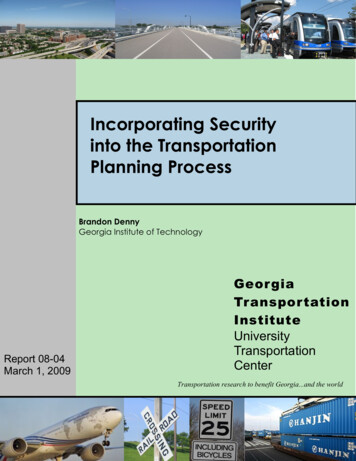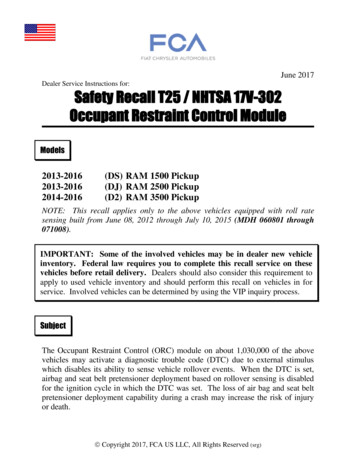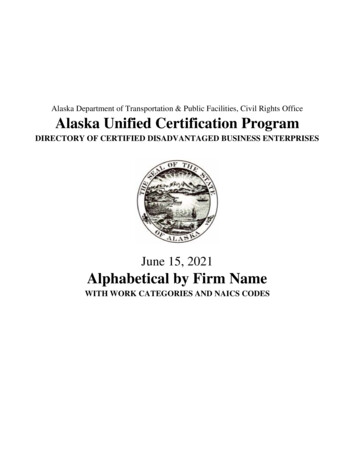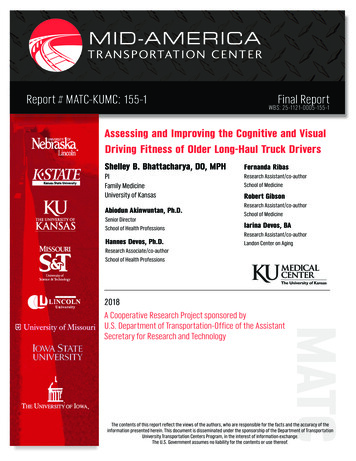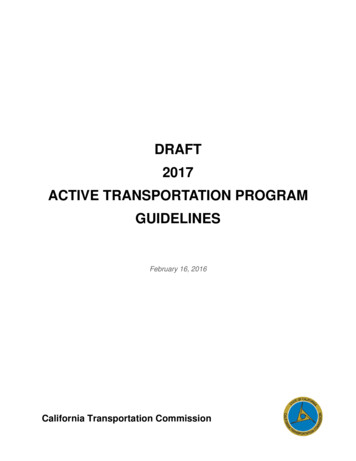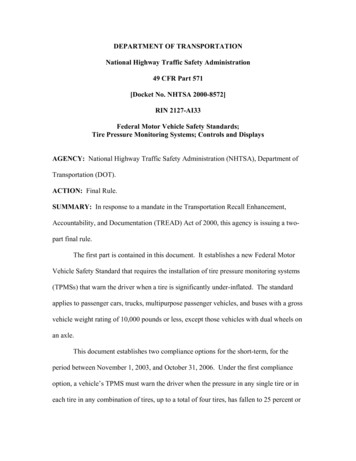
Transcription
DEPARTMENT OF TRANSPORTATIONNational Highway Traffic Safety Administration49 CFR Part 571[Docket No. NHTSA 2000-8572]RIN 2127-AI33Federal Motor Vehicle Safety Standards;Tire Pressure Monitoring Systems; Controls and DisplaysAGENCY: National Highway Traffic Safety Administration (NHTSA), Department ofTransportation (DOT).ACTION: Final Rule.SUMMARY: In response to a mandate in the Transportation Recall Enhancement,Accountability, and Documentation (TREAD) Act of 2000, this agency is issuing a twopart final rule.The first part is contained in this document. It establishes a new Federal MotorVehicle Safety Standard that requires the installation of tire pressure monitoring systems(TPMSs) that warn the driver when a tire is significantly under-inflated. The standardapplies to passenger cars, trucks, multipurpose passenger vehicles, and buses with a grossvehicle weight rating of 10,000 pounds or less, except those vehicles with dual wheels onan axle.This document establishes two compliance options for the short-term, for theperiod between November 1, 2003, and October 31, 2006. Under the first complianceoption, a vehicle’s TPMS must warn the driver when the pressure in any single tire or ineach tire in any combination of tires, up to a total of four tires, has fallen to 25 percent or
2more below the vehicle manufacturer’s recommended cold inflation pressure for the tires,or a minimum level of pressure specified in the standard, whichever pressure is higher.Under the second compliance option, a vehicle’s TPMS must warn the driver when thepressure in any single tire has fallen to 30 percent or more below the vehiclemanufacturer’s recommended cold inflation pressure for the tires, or a minimum level ofpressure specified in the standard, whichever pressure is higher. Compliance with theoptions would be phased in during that period by increasing percentages of production.The second part of this final rule will be issued by March 1, 2005, and willestablish performance requirements for the long-term, i.e., for the period beginning onNovember 1, 2006. In the meantime, the agency will leave the rulemaking docket openfor the submission of new data and analyses concerning the performance of TPMSs. Theagency also will conduct a study comparing the tire pressures of vehicles without anyTPMS to the pressures of vehicles with TPMSs, especially TPMSs that do not complywith the four-tire, 25 percent compliance option.Based on the record now before the agency, NHTSA tentatively believes that thefour-tire, 25 percent option would best meet the mandate in the TREAD Act. However, itis possible that the agency may obtain or receive new information that is sufficient tojustify a continuation of the options established by this first part of this rule, or theadoption of some other alternative.DATES: This final rule is effective [insert date that is 30 days after publication in theFederal Register]. Under the rule, vehicles will be required to comply with therequirements of the standard according to a phase-in beginning on November 1, 2003. Ifyou wish to submit a petition for reconsideration of this rule, your petition must be
3received by [insert date that is 45 days after the date of publication in the FederalRegister].ADDRESSES: Petitions for reconsideration should refer to the docket number and besubmitted to: Administrator, Room 5220, National Highway Traffic SafetyAdministration, 400 Seventh Street, SW, Washington, D.C. 20590.FOR FURTHER INFORMATION CONTACT: For technical and other non-legalissues, you may call Mr. George Soodoo or Mr. Joseph Scott, Office of Crash AvoidanceStandards (Telephone: 202-366-2720) (Fax: 202-366-4329).For legal issues, you may call Mr. Dion Casey, Office of Chief Counsel(Telephone: 202-366-2992) (Fax: 202-366-3820).You may send mail to these officials at National Highway Traffic SafetyAdministration, 400 Seventh Street, SW, Washington, D.C. 20590.You may call Docket Management at 202-366-9324. You may visit the Docketon the plaza level at 400 Seventh Street, SW, Washington, D.C., from 10:00 a.m. to 5:00p.m., Monday through Friday.SUPPLEMENTARY INFORMATION:Table of ContentsI.II.Executive SummaryA.Highlights of the Notice of Proposed RulemakingB.Highlights of the Preliminary Determination About the Final RuleC.OMB Return LetterD.Highlights of the Final Rule1.Part One – Phase-in (November 2003 through October 2006)2.Part Two – November 2006 and ThereafterE.Summary Comparison of Preliminary Determination and the FinalRuleBackgroundA.The Transportation Recall Enhancement, Accountability, andDocumentation Act
4B.C.D.III.IV.V.VI.VII.Previous Rulemaking on Tire Pressure Monitoring SystemsSummary of the Notice of Proposed RulemakingSummary of Public Comments on Notice1.Vehicles Covered2.Phase-in Options and Long-Term Requirementsa.Definition of “Significantly Under-Inflated”b.Number of Tires Monitored3.Lead Time4.Reliability5.Costs and Benefits EstimatesE.Submission of Draft Final Rule to OMBF.OMB Return LetterG.Public Comments on OMB’s Return LetterH.Congressional HearingSafety ProblemA.Infrequent Driver Monitoring of Tire PressureB.Loss of Tire Pressure Due to Natural and Other CausesC.Percentage of Motor Vehicles with Under-Inflated TiresD.Consequences of Under-Inflation of Tires1.Reduced Vehicle Safety – Tire Failures and Increases inStopping Distance2.Reduced Tread Life3.Reduced Fuel EconomyTire Pressure Monitoring SystemsA.Indirect TPMSsB.Direct TPMSsC.Hybrid TPMSsSummary of Preliminary Determination About the Final RuleA.Alternative Long-Term Requirements Analyzed in MakingPreliminary DeterminationB.Phase-In and Long-Term RequirementsResponse to Issues Raised in OMB Return Letter About PreliminaryDeterminationA.Criteria for Selecting the Long-Term Requirement1.Tire Safety and Overall Vehicle Safety2.Statutory MandateB.Relative Ability of Direct and Current Indirect TPMSs to DetectUnder-InflationC.Analysis of a Fourth Alternative Long-Term Requirement: One-Tire,30 Percent Under-Inflation DetectionD.Impact of One-Tire, 30 Percent Alternative on Installation Rate ofABSE.Overall Safety Effects of ABSF.Technical Foundation for NHTSA’s Safety Benefit AnalysesThe Final RuleA.Decision to Issue Two-Part Final Rule
5B.Part One of the Final Rule – November 2003 through October 20061.Summary2.Congressional Intent3.Vehicles Covered4.Phase-In Options and Requirementsa.Alternatives Consideredi.Threshold Level of Under-Inflationii.Number of Tires Monitoredb.Option One: Four Tires, 25 Percent Under-Inflationc.Option Two: One Tire, 30 Percent Under-Inflationd.Special Written Instructions for Option Two TPMSs5.Other Requirementsa.Time Frame for Telltale Illuminationb.Duration of Warningc.Temporary Disablementd.System Calibratione.Replacement Tiresf.Monitoring of Spare Tireg.Temperature Compensationh.Low Tire Pressure Warning Telltalei.Colorii.Symboliii.Self-Checki.General Written Instructions for All TPMSsj.Test Conditionsk.Test Procedures6.Lead TimeC.Study of Effects of TPMSs That Do Not Meet a Four-Tire, 25 PercentUnder-Inflation Requirement1.Effect on Tire Pressure2.Effect on Number of Significantly Under-Inflated TiresD.Part Two of the Final Rule – November 2006 and ThereafterVIII. BenefitsA.Tire Safety Benefits1.Skidding/Loss of Control2.Stopping Distance3.Flat Tires and Blowouts4.Unquantified BenefitsB.Non-Tire Safety BenefitsC.Total Quantified Safety BenefitsD.Economic Benefits1.Fuel Economy2.Tread LifeIX.CostsA.Indirect TPMSsB.Direct TPMSs
6X.C.Hybrid TPMSsD.Vehicle CostE.Maintenance CostsF.Testing CostsG.Unquantified CostsH.ABS CostsI.Net Costs and Costs Per Equivalent Life SavedRulemaking Analyses and NoticesI.Executive SummaryA.Highlights of the Notice of Proposed RulemakingNHTSA initiated this rulemaking with the publication of a Notice of ProposedRulemaking (NPRM)(66 FR 38982, Docket No. NHTSA-2000-8572) on July 26, 2001.The NPRM proposed to require passenger cars, light trucks, multipurpose passengervehicles, and buses with a gross vehicle weight rating of 10,000 pounds or less, exceptthose vehicles with dual wheels on an axle, to be equipped with a tire pressure monitoringsystem (TPMS).The agency sought comment on two alternative sets of performance requirementsfor TPMSs and proposed adopting one of them in the final rule. The first alternativewould have required that the driver be warned when the pressure in any single tire or ineach tire in any combination of tires, up to a total of four tires, had fallen to 20 percent ormore below the vehicle manufacturer’s recommended cold inflation pressure for thevehicle’s tires (the placard pressure), or a minimum level of pressure specified in thestandard, whichever was higher. (This alternative is referred to below as the four-tire, 20percent alternative.) The second alternative would have required that the driver bewarned when the pressure in any single tire or in each tire in any combination of tires, upto a total of three tires, had fallen to 25 percent or more below the placard pressure, or aminimum level of pressure specified in the standard, whichever was higher. (This
7alternative is referred to below as the three-tire, 25 percent alternative.) The minimumlevels of pressure were the same in both proposed alternatives. The adoption of four-tire,20 percent alternative would have required that drivers be warned of under-inflationsooner and in a greater array of circumstances. It would also have narrowed the range oftechnologies that manufacturers could use to comply with the new standard.There are two types of TPMSs currently available, direct TPMSs and indirectTPMSs. Direct TPMSs have a tire pressure sensor in each tire. The sensors transmitpressure information to a receiver. Indirect TPMSs do not have tire pressure sensors.Current indirect TPMSs rely on the wheel speed sensors in an anti-lock braking system(ABS) to detect and compare differences in the rotational speed of a vehicle’s wheels.Those differences correlate to differences in tire pressure because decreases in tirepressure cause decreases in tire diameter that, in turn, cause increases in wheel speed.To meet the four-tire, 20 percent alternative, vehicle manufacturers likely wouldhave had to use direct TPMSs because even improved indirect systems would not likelybe able to detect loss of pressure until pressure has fallen 25 percent and could not detectall combinations of significantly under-inflated tires. To meet the three-tire, 25 percentalternative, vehicle manufacturers would have been able to install either direct TPMSs orimproved indirect TPMSs, but not current indirect TPMSs.B.Highlights of the Preliminary Determination About the Final RuleNHTSA preliminarily determined to issue a final rule that would have specified afour-year phase-in schedule1 and allowed compliance with either of two options during1The phase-in schedule was as follows: 10 percent of a manufacturer’s affected vehicles would have had tocomply with either compliance option in the first year; 35 percent in the second year; and 65 percent in thethird year. In the fourth year, 100 percent of a manufacturer’s affected vehicles would have had to complywith the long-term requirements, i.e., the four-tire, 25 percent compliance option.
8the phase-in, i.e., between November 1, 2003 and October 31, 2006. Under the firstoption, a vehicle’s TPMS would have had to warn the driver when the pressure in one ormore of the vehicle’s tires, up to a total of four tires, was 25 percent or more below theplacard pressure, or a minimum level of pressure specified in the standard, whicheverpressure was higher. (This option is referred to below as the four-tire, 25 percent option.)Under the second option, a vehicle’s TPMS would have had to warn the driver when thepressure in any one of the vehicle’s tires was 30 percent or more below the placardpressure, or a minimum level of pressure specified in the standard, whichever pressurewas higher. (This option is referred to below as the one-tire, 30 percent option.) Theminimum levels of pressure specified in the standard were the same for both complianceoptions.After the phase-in, i.e., after October 31, 2006, the second option would havebeen terminated, and the provisions of the first option would have become mandatory forall new vehicles. Thus, all vehicles would have been required to meet a four-tire, 25percent requirement.C.OMB Return LetterAfter reviewing the draft final rule, OMB returned it to NHTSA forreconsideration, with a letter explaining its reasons for doing so, on February 12, 2002.In the letter, OMB stated its belief that the draft final rule and accompanying regulatoryimpact analysis did not adequately demonstrate that the agency had selected the bestavailable method of improving overall vehicle safety.D.Highlights of the Final Rule
9In response to the OMB return letter, the agency has decided to divide the finalrule into two parts. The first part is contained in this document, which establishesrequirements for vehicles manufactured during the first three years, i.e., betweenNovember 1, 2003, and October 31, 2006, and phases them in by increasing percentagesof production. The second part will establish requirements for vehicles manufactured onor after November 1, 2006.The agency has divided the final rule into two parts because it has decided todefer its decision as to which long-term performance requirements for TPMS would bestsatisfy the mandate of the TREAD Act. This deferral will allow the agency’sconsideration of additional data on the effect and performance of TPMSs. From thebeginning, the agency has sought to comply with the mandate and safety goals of theTREAD Act in a way that encourages innovation and allows a range of technologies tothe extent consistent with providing drivers with sufficient warning of low tire pressureunder a broad variety of the reasonably foreseeable circumstances in which tires becomeunder-inflated.1.Part One – Phase-in (November 2003 through October 2006)NHTSA has decided to require vehicle manufacturers to equip their light vehicles(i.e., those with a gross vehicle weight rating (GVWR) of 10,000 lbs. or less) withTPMSs and to give them the option for complying with either of two sets of performancerequirements during the period covered by the first part of the final rule, i.e., fromNovember 1, 2003 to October 31, 2006. The options are the same as those in thepreliminary determination about the final rule.
10Under the first set or compliance option, the vehicle’s TPMS will be required towarn the driver when the pressure in any single tire or in each tire in any combination oftires, up to a total of four tires, is 25 percent or more below the vehicle manufacturer’srecommended cold inflation pressure for the tires, or a minimum level of pressurespecified in the standard, whichever pressure is higher. Under the second complianceoption, the vehicle’s TPMS will be required to warn the driver when the pressure in anysingle tire is 30 percent or more below the vehicle manufacturer’s recommended coldinflation pressure for the tires, or a minimum level of pressure specified in the standard,whichever pressure is higher.2The two compliance options are outgrowths of the alternative sets of requirementsproposed in the NPRM. In response to comments confirming that current indirectTPMSs cannot meet the proposed three-tire, 25 percent under-inflation requirements, andin order to allow those systems to be used during the phase-in, the agency is adoptingrequirements for detection of one-tire, 30 percent under-inflation as the first option. Forthe second option, the agency is adopting requirements for detection of 4-tire, 25 percentunder-inflation. Adopting those requirements, instead of the proposed requirements forfour-tire, 20 percent under-inflation, will permit manufacturers to use either directTPMSs or hybrid TPMSs, i.e., TPMSs that combine direct and indirect TPMStechnologies. One TPMS supplier indicated the potential for developing and producinghybrid systems, although it also indicated that it did not currently have plans for doing so.The agency believes that the difference in benefits between TPMSs meeting four-tire, 20percent requirements and TPMSs meeting four-tire, 25 percent requirements should notbe substantial.2The minimum levels of pressure are the same for both compliance options.
11To facilitate compliance with the options, the rule phases them in by increasingpercentages of production. Ten percent of a vehicle manufacturer’s light vehicles will berequired to comply with either compliance option during the first year (November 1,2003 to October 31, 2004), 35 percent during the second year (November 1, 2004 toOctober 31, 2005), and 65 percent during the third year (November 1, 2005 to October31, 2006). These percentages are the same as those in the preliminary determinationabout the final rule. The agency is allowing carry-forward credits for vehicles that aremanufactured during the phase-in and are equipped with TPMSs that comply with thefour-tire, 25 percent option. It is not allowing credits for TPMSs complying with theother option for the same reason that the agency is requiring manufacturers to provideconsumers with information about the performance limitations of those systems.The combination of the two compliance options and the phase-in will allowmanufacturers to continue to use current indirect TPMSs during that period and ease theimplementation of the TPMS standard. The agency notes that, for vehicles alreadyequipped with ABS, the installation of a current indirect TPMS is the least expensive wayof complying with a TPMS standard. The compliance options and phase-in will also givemanufacturers the flexibility needed to innovate and improve the performance of theirTPMSs. This flexibility will improve the chances that ways can be found to improve thedetection of under-inflation as well as reduce the costs of doing so.The owner’s manual for vehicles certified to either compliance option will be required toinclude written information explaining the purpose of the low tire pressure warningtelltale, the potential consequences of driving on significantly under-inflated tires, themeaning of the telltale when it is illuminated, and the actions that drivers should take
12when the telltale is illuminated. In addition, the owner’s manual in vehicles certified tothe one-tire, 30 percent option will be required to include information on the inherentperformance limitations of current indirect TPMSs because the agency anticipates thatmost indirect TPMSs installed to comply with that option will exhibit those limitationsand because a vehicle owner survey indicates that a significant majority of drivers wouldbe less concerned, to either a great extent or a very great extent, with routinelymaintaining the pressure of their tires if their vehicle were equipped with a TPMS. Underboth compliance options, the TPMS will be required to have a low tire pressure-warningtelltale (yellow).2.Part Two – November 2006 and ThereafterBeginning November 1, 2006, all passenger cars and light trucks, multipurposepassenger vehicles, and buses under 10,000 pounds GVWR will be required to complywith the requirements in the second part of this final rule. The agency will publish thesecond part of this final rule by March 1, 2005, in order to give manufacturers sufficientlead time before vehicles must meet the requirements.In anticipation of making the decision in part two of this final rule about the longterm requirements, the agency will leave the rulemaking docket open for the submissionof new data and analyses. The agency also will conduct a study comparing the tirepressures of vehicles without any TPMS to the pressures of vehicles with TPMSs that donot comply with the four-tire, 25 percent compliance option. When completed, it will beplaced in the docket for public examination. After consideration of the record compiledto this date, as supplemented by the results of the tire pressure study and any other new
13information submitted to the agency, NHTSA will issue the second part of this rule byMarch 1, 2005.Based on the record now before the agency, NHTSA tentatively believes that thefour-tire, 25 percent option would best meet the mandate in the TREAD Act. However, itis possible that the agency may obtain or receive new information that is sufficient tojustify a continuation of the compliance options established by the first part of this finalrule, or the adoption of some other alternative.E.Summary Comparison of the Preliminary Determination and theFinal RuleThe primary difference between the preliminary determination and the final ruleis one of timing, instead of substance. The options and percentages of production for thephase-in years are unchanged.3 The final rule does differ from the preliminarydetermination in the timing of the agency's decision about the performance requirementsfor the years following the phase-in period.3The final rule does require that additional information be placed in the vehicle's owner manual.
14Summary Comparison of the Preliminary Determination and the Final RuleApplicationShort-term(11/1/03 - m(11/1/06 &thereafter)PerformanceRequirementsPreliminary DeterminationPassenger cars, trucks, multipurpose passengervehicles, and buses with a GVWR of 10,000pounds or less, except those vehicles with dualwheels on an axleFinal RuleSameSameOption 1: TPMS must warn the driver when thepressure in any single tire or in each tire in anycombination of tires, up to a total of four tires,has fallen to 25 percent or more below the vehiclemanufacturer’s recommended cold inflationpressure for the tires, or a minimum level ofpressure specified in the standard, whicheverpressure is higher.SameOption 2: TPMS must warn the driver when thepressure in any single tire has fallen to 30 percentor more below the vehicle manufacturer’srecommended cold inflation pressure for the tires,or a minimum level of pressure specified in thestandard, whichever pressure is higher.Same10% of a vehicle manufacturer’s light vehicleswill be required to comply with either complianceoption during the first year (November 1, 2003 toOctober 31, 2004), 35 percent during the secondyear (November 1, 2004 to October 31, 2005),and 65 percent during the third year (November1, 2005 to October 31, 2006).TPMS must warn the driver when the pressure inany single tire or in each tire in any combinationof tires, up to a total of four tires, has fallen to 25percent or more below the vehicle manufacturer’srecommended cold inflation pressure for the tires,or a minimum level of pressure specified in thestandard, whichever pressure is higher.Decision tobe made byMarch 1,2005
15II.BackgroundA.The Transportation Recall Enhancement, Accountability, andDocumentation ActCongress enacted the TREAD Act on November 1, 2000.4 Section 13 of theTREAD Act mandated the completion of “a rulemaking for a regulation to require awarning system in new motor vehicles to indicate to the operator when a tire issignificantly under inflated” within one year of the TREAD Act’s enactment. Section 13also requires the regulation to take effect within two years of the completion of therulemaking.B.Previous Rulemaking on Tire Pressure Monitoring SystemsNHTSA first considered requiring a “low tire pressure warning” device in 1970.However, the agency determined that the only warning device available at that time wasan in-vehicle indicator whose cost was too high.During the 1970s, several manufacturers developed inexpensive, on-tire warningdevices. In addition, the price of in-vehicle warning devices dropped significantly.As a result, on January 26, 1981, NHTSA published an Advanced Notice ofProposed Rulemaking (ANPRM) soliciting public comment on whether the agencyshould propose a new Federal motor vehicle safety standard requiring each new motorvehicle to have a low tire pressure warning device which would “warn the driver whenthe tire pressure in any of the vehicle’s tires was significantly below the recommendedoperating levels.” (46 FR 8062.)NHTSA noted in the ANPRM that under-inflation increases the rolling resistanceof tires and, correspondingly, decreases the fuel economy of vehicles. Research data at4Public Law 106-414.
16the time indicated that the under-inflation of a vehicle’s radial tires by 10 pounds persquare inch (psi) reduced the fuel economy of the vehicle by 3 percent. Because of theworldwide oil shortages in the late 1970s and early 1980s, NHTSA was interested infinding ways to increase the fuel economy of passenger vehicles (i.e., passenger cars andmultipurpose passenger vehicles). Since surveys by the agency showed that about 50percent of passenger car tires and 13 percent of truck tires were operated at pressuresbelow the vehicle manufacturer’s recommended (placard) pressure, the agency believedthat low tire pressure warning devices would encourage drivers to maintain their tires atthe proper inflation level, thus maximizing their vehicles’ fuel economy.Moreover, a 1977 study by Indiana University concluded that under-inflated tireswere a probable cause of 1.4 percent of all motor vehicle crashes.5 Based on that figure,and the approximately 18.3 million motor vehicle crashes then occurring annually in theUnited States, the agency suggested that under-inflated tires were probably responsiblefor 260,000 crashes each year (1.4 percent x 18.3 million crashes).In the ANPRM, NHTSA sought answers from the public to several questions,including:(1)What tire pressure level should trigger the warning device?(2)Should the agency specify the type of warning device (i.e., on-tire or invehicle) to be used?(3)What would it cost to produce and install an on-tire or in-vehicle warningdevice?(4)5What is the fuel saving potential of low tire pressure warning devices?Tri-Level Study of the Causes of Traffic Accidents, Treat, J.R., et al. (1979) (Contract No. DOT HS 0343-535), DOT HS 805 099, Washington, DC: U.S. Department of Transportation, National Highway TrafficSafety Administration.
17(5)What studies have been performed which would show cause and effectrelationships between low tire pressure and auto crashes?(6)What would be the costs and benefits of a program to educate the publicon the benefits of maintaining proper tire pressure?NHTSA terminated the rulemaking on August 31, 1981, because publiccomments indicated that the low tire pressure warning devices available at the time eitherhad not been proven to be accurate and reliable (on-tire devices) or were too expensive(in-vehicle devices). (46 FR 43721.) The comments indicated that in-vehicle warningdevices had been proven to be accurate and reliable, but would have had a retail cost of 200 (in 1981 dollars) per vehicle. NHTSA stated, “Such a cost increase cannot bejustified by the potential benefits, although those benefits might be significant.” (46 FR43721.) The comments also indicated that on-tire warning devices cost only about 5 (in1981 dollars), but they had not been developed to the point where they were accurate andreliable enough to be required. The comments also suggested that on-tire warningdevices were subject to damage by road hazards, such as ice and mud, as well as scuffingat curbs. Despite terminating the rulemaking, the agency stated that it still believed that“[m]aintaining proper tire inflation pressure results in direct savings to drivers in terms ofbetter gas mileage and longer tire life, as well as offering increased safety.” (46 FR43721.)C.Summary of the Notice of Proposed RulemakingOn July 26, 2001, the agency published the NPRM proposing to establish astandard for TPMSs pursuant to section 13 of the TREAD Act. (66 FR 38982.) Theagency proposed two alternative versions of the standard.
18The two alternatives differed in two important respects: in how they defined“significantly under-inflated,” and in the number of significantly under-inflated tires thatthey would be required to be able to detect at any one time. The first alternative (fourtires, 20 percent) would have defined “significantly under-inflated” as the tire pressure 20percent or more below the placard pressure, or a minimum level of pressure specified inthe standard, whichever was higher. It would have required the low tire pressure warningtelltale to illuminate when any tire, or when each tire in any combination of tires, on thevehicle became significantly under-inflated.The second alternative (three tires, 25 percent) would have defined “significantlyunder-inflated” as the tire pressure 25 percent or more below the placard pressure, or aminimum level of pressure specified in the standard, whichever was higher. Theminimum levels of pressure were the same in both proposed alternatives. The alternativewould have required the low tire pressure warning telltale to illuminate when any tire, orwhen each tire in any combination of tires, up to a total of three tires, becamesignificantly under-inflated.In most other respects, the two alternatives were identical. Both would haverequired passenger cars, multipurpose passenger vehicles, trucks, and buses with aGVWR of 4,536 kilograms (10,000 pounds) or less, manufactured on or after November1, 2003, to be equipped with a TPMS and a low tire pressure warning telltale (yellow) toalert the driver. They would have required the telltale to illuminate within 10 minutes ofdriving after any tire on the vehicle became significantly under-inflated. They wouldhave required the telltale to remain illuminated as long as any of the vehicle’s tiresremained significantly under-inflated, and the key locking system was in the “On”
19(“Run”) position. They would have required that the telltale be deactivatable, manuallyor automatically, only when the vehicle no longer had a tire that was significantly underinflated. They would have required the TPMS in each veh
I. Net Costs and Costs Per Equivalent Life Saved X. Rulemaking Analyses and Notices I. Executive Summary A. Highlights of the Notice of Proposed Rulemaking NHTSA initiated this rulemaking with the publication of a Notice of Proposed Rulemaking (NPRM)(6

